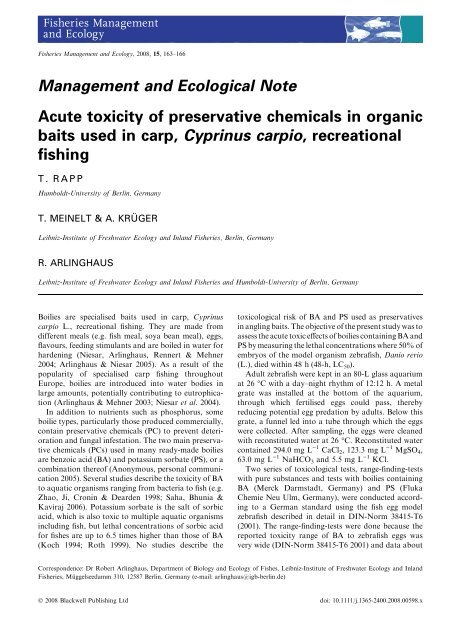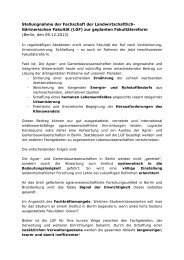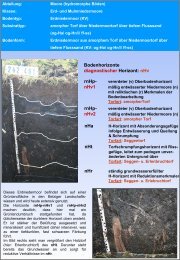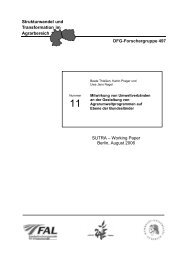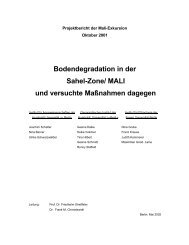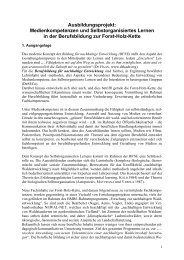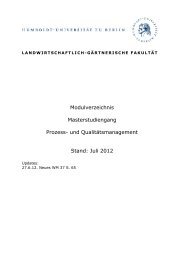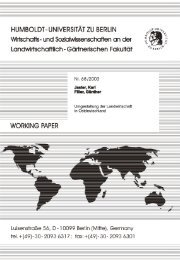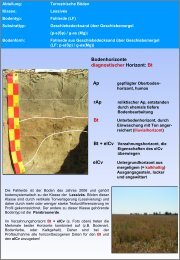Acute toxicity of preservative chemicals in organic baits used in carp ...
Acute toxicity of preservative chemicals in organic baits used in carp ...
Acute toxicity of preservative chemicals in organic baits used in carp ...
You also want an ePaper? Increase the reach of your titles
YUMPU automatically turns print PDFs into web optimized ePapers that Google loves.
Fisheries Management<br />
and Ecology<br />
Fisheries Management and Ecology, 2008, 15, 163–166<br />
Management and Ecological Note<br />
<strong>Acute</strong> <strong>toxicity</strong> <strong>of</strong> <strong>preservative</strong> <strong>chemicals</strong> <strong>in</strong> <strong>organic</strong><br />
<strong>baits</strong> <strong>used</strong> <strong>in</strong> <strong>carp</strong>, Cypr<strong>in</strong>us <strong>carp</strong>io, recreational<br />
fish<strong>in</strong>g<br />
T. RAPP<br />
Humboldt-University <strong>of</strong> Berl<strong>in</strong>, Germany<br />
T. MEINELT & A. KRÜGER<br />
Leibniz-Institute <strong>of</strong> Freshwater Ecology and Inland Fisheries, Berl<strong>in</strong>, Germany<br />
R. ARLINGHAUS<br />
Leibniz-Institute <strong>of</strong> Freshwater Ecology and Inland Fisheries and Humboldt-University <strong>of</strong> Berl<strong>in</strong>, Germany<br />
Boilies are specialised <strong>baits</strong> <strong>used</strong> <strong>in</strong> <strong>carp</strong>, Cypr<strong>in</strong>us<br />
<strong>carp</strong>io L., recreational fish<strong>in</strong>g. They are made from<br />
different meals (e.g. fish meal, soya bean meal), eggs,<br />
flavours, feed<strong>in</strong>g stimulants and are boiled <strong>in</strong> water for<br />
harden<strong>in</strong>g (Niesar, Arl<strong>in</strong>ghaus, Rennert & Mehner<br />
2004; Arl<strong>in</strong>ghaus & Niesar 2005). As a result <strong>of</strong> the<br />
popularity <strong>of</strong> specialised <strong>carp</strong> fish<strong>in</strong>g throughout<br />
Europe, boilies are <strong>in</strong>troduced <strong>in</strong>to water bodies <strong>in</strong><br />
large amounts, potentially contribut<strong>in</strong>g to eutrophication<br />
(Arl<strong>in</strong>ghaus & Mehner 2003; Niesar et al. 2004).<br />
In addition to nutrients such as phosphorus, some<br />
boilie types, particularly those produced commercially,<br />
conta<strong>in</strong> <strong>preservative</strong> <strong>chemicals</strong> (PC) to prevent deterioration<br />
and fungal <strong>in</strong>festation. The two ma<strong>in</strong> <strong>preservative</strong><br />
<strong>chemicals</strong> (PCs) <strong>used</strong> <strong>in</strong> many ready-made boilies<br />
are benzoic acid (BA) and potassium sorbate (PS), or a<br />
comb<strong>in</strong>ation there<strong>of</strong> (Anonymous, personal communication<br />
2005). Several studies describe the <strong>toxicity</strong> <strong>of</strong> BA<br />
to aquatic organisms rang<strong>in</strong>g from bacteria to fish (e.g.<br />
Zhao, Ji, Cron<strong>in</strong> & Dearden 1998; Saha, Bhunia &<br />
Kaviraj 2006). Potassium sorbate is the salt <strong>of</strong> sorbic<br />
acid, which is also toxic to multiple aquatic organisms<br />
<strong>in</strong>clud<strong>in</strong>g fish, but lethal concentrations <strong>of</strong> sorbic acid<br />
for fishes are up to 6.5 times higher than those <strong>of</strong> BA<br />
(Koch 1994; Roth 1999). No studies describe the<br />
toxicological risk <strong>of</strong> BA and PS <strong>used</strong> as <strong>preservative</strong>s<br />
<strong>in</strong> angl<strong>in</strong>g <strong>baits</strong>. The objective <strong>of</strong> the present study was to<br />
assess the acute toxic effects <strong>of</strong> boilies conta<strong>in</strong><strong>in</strong>g BA and<br />
PS by measur<strong>in</strong>g the lethal concentrations where 50% <strong>of</strong><br />
embryos <strong>of</strong> the model organism zebrafish, Danio rerio<br />
(L.), died with<strong>in</strong> 48 h (48-h, LC 50).<br />
Adult zebrafish were kept <strong>in</strong> an 80-L glass aquarium<br />
at 26 °C with a day–night rhythm <strong>of</strong> 12:12 h. A metal<br />
grate was <strong>in</strong>stalled at the bottom <strong>of</strong> the aquarium,<br />
through which fertilised eggs could pass, thereby<br />
reduc<strong>in</strong>g potential egg predation by adults. Below this<br />
grate, a funnel led <strong>in</strong>to a tube through which the eggs<br />
were collected. After sampl<strong>in</strong>g, the eggs were cleaned<br />
with reconstituted water at 26 °C. Reconstituted water<br />
conta<strong>in</strong>ed 294.0 mg L )1 CaCl2, 123.3 mg L )1 MgSO4,<br />
63.0 mg L )1 NaHCO3 and 5.5 mg L )1 KCl.<br />
Two series <strong>of</strong> toxicological tests, range-f<strong>in</strong>d<strong>in</strong>g-tests<br />
with pure substances and tests with boilies conta<strong>in</strong><strong>in</strong>g<br />
BA (Merck Darmstadt, Germany) and PS (Fluka<br />
Chemie Neu Ulm, Germany), were conducted accord<strong>in</strong>g<br />
to a German standard us<strong>in</strong>g the fish egg model<br />
zebrafish described <strong>in</strong> detail <strong>in</strong> DIN-Norm 38415-T6<br />
(2001). The range-f<strong>in</strong>d<strong>in</strong>g-tests were done because the<br />
reported <strong>toxicity</strong> range <strong>of</strong> BA to zebrafish eggs was<br />
very wide (DIN-Norm 38415-T6 2001) and data about<br />
Correspondence: Dr Robert Arl<strong>in</strong>ghaus, Department <strong>of</strong> Biology and Ecology <strong>of</strong> Fishes, Leibniz-Institute <strong>of</strong> Freshwater Ecology and Inland<br />
Fisheries, Mu¨ ggelseedamm 310, 12587 Berl<strong>in</strong>, Germany (e-mail: arl<strong>in</strong>ghaus@igb-berl<strong>in</strong>.de)<br />
Ó 2008 Blackwell Publish<strong>in</strong>g Ltd doi: 10.1111/j.1365-2400.2008.00598.x
164<br />
T. RAPP ET AL.<br />
the <strong>toxicity</strong> <strong>of</strong> PS were not available. In the rangef<strong>in</strong>d<strong>in</strong>g-tests,<br />
BA was tested at concentrations <strong>of</strong> 10–<br />
100 mg L )1 . Only one concentration <strong>of</strong> PS (1000 mg<br />
L )1 ) was prelim<strong>in</strong>arily <strong>in</strong>vestigated because limited<br />
toxicological impact below this concentration (Pass<strong>in</strong>o<br />
& Smith 1987). However, s<strong>in</strong>ce BA and PS are <strong>of</strong>ten<br />
<strong>used</strong> together <strong>in</strong> boilies at a proportion <strong>of</strong> 3:2<br />
(Anonymous, personal communication), a further test<br />
<strong>of</strong> comb<strong>in</strong>ed pure substances was performed to detect<br />
possible additive or antagonistic effects. Based on the<br />
range <strong>of</strong> <strong>toxicity</strong> <strong>of</strong> BA from the range-f<strong>in</strong>d<strong>in</strong>g-test<br />
described above, concentrations <strong>of</strong> BA from 90–<br />
100 mg L )1 adjusted to a pH <strong>of</strong> 7.0 ± 0.2 were<br />
exam<strong>in</strong>ed to determ<strong>in</strong>e the 48-h, LC50. Concentrations<br />
<strong>of</strong> PS ranged between 60 and 66 mg L )1 . Ten zebrafish<br />
eggs <strong>in</strong> the four- to eight-cell stage were placed <strong>in</strong> cell<br />
wells and <strong>in</strong>cubated for 48 h at a constant temperature<br />
<strong>of</strong> 26 °C. Death was def<strong>in</strong>ed as coagulation <strong>of</strong> eggs,<br />
absence <strong>of</strong> heart beat, non-appearance <strong>of</strong> somites and<br />
no detachment <strong>of</strong> the tail from the yolk sac.<br />
The toxicological tests were conducted with four<br />
types <strong>of</strong> boilies, two commercially available, readymade<br />
boilies from companies A and B purchased <strong>in</strong> a<br />
local angl<strong>in</strong>g shop <strong>in</strong> Berl<strong>in</strong>, Germany and self-made<br />
boilies. The self-made boilies were made us<strong>in</strong>g a<br />
commercially available boilie mix lack<strong>in</strong>g PC (M&M<br />
Baits, Yellow Birdfoodmix), to which 3% BA and 2%<br />
PS, based on fresh weight, were added. Boilies were<br />
made as they would be by anglers add<strong>in</strong>g eggs, cook<strong>in</strong>g<br />
for 90 s and dry<strong>in</strong>g at the air for 24 h. The concentration<br />
<strong>of</strong> BA and PS was chosen because the manager<br />
<strong>of</strong> a large boilie manufacturer <strong>in</strong>dicated that PC is<br />
<strong>of</strong>ten added to boilie mixes at 5% <strong>of</strong> the fresh boilie<br />
mixture (Anonymous, personal communication). Selfmade<br />
boilies without PC served as a control. Each type<br />
<strong>of</strong> boilie was tested as whole boilie as well as divided<br />
(split) boilie. Many anglers employ split boilies to<br />
<strong>in</strong>crease attractiveness <strong>of</strong> the groundbait location<br />
through enhanced leakage <strong>of</strong> feed<strong>in</strong>g stimulants as a<br />
result <strong>of</strong> <strong>in</strong>creased surface area per boilie (T. Rapp,<br />
personal observation). Three to 17 g L )1 <strong>of</strong> whole<br />
boilies and 2 to 15 g L )1 split boilies <strong>in</strong> 1 g L )1 steps<br />
were added to reconstituted water for 24 h to allow<br />
leakage <strong>of</strong> <strong>preservative</strong>s. Investigations were conducted<br />
at a s<strong>in</strong>gle concentration <strong>of</strong> 20 g L )1 for boilies<br />
without <strong>preservative</strong>s. As a result <strong>of</strong> high oxygen<br />
consumption result<strong>in</strong>g from microbiological activity <strong>in</strong><br />
the test with self-made boilies without PC, the eggs<br />
were aerated via a th<strong>in</strong> tube (Pasteur aeration).<br />
For all tests, the 48-h, LC 50 was calculated by probit<br />
analysis us<strong>in</strong>g SPSS 9.0 (SPSS Inc., Chicago, IL, USA),<br />
except <strong>in</strong> tests where only one concentration was<br />
employed. Sample size per concentration was n =10<br />
eggs. Values are expressed for the 48-h, LC 50 as mg L )1<br />
<strong>of</strong> the chemical for the range-f<strong>in</strong>d<strong>in</strong>g-tests and for the<br />
boilie tests <strong>in</strong> g L )1 boilies. Differences <strong>in</strong> the 48-h,<br />
LC50 among treatments <strong>in</strong> the range-f<strong>in</strong>d<strong>in</strong>g-tests as<br />
well as <strong>in</strong> the boilie tests were tested statistically as<br />
described <strong>in</strong> Loza´n & Kausch (2004, p. 273). In the<br />
boilie tests, whole and split boilies <strong>of</strong> the same type and<br />
whole boilies <strong>of</strong> different types were compared. Significance<br />
was judged at P < 0.05. All values reported are<br />
averages with the 95% confidence <strong>in</strong>terval denoted.<br />
For BA, a mean 48-h, LC50 <strong>of</strong> 96.1 mg L )1 (95.6 –<br />
96.6 mg L )1 ) was determ<strong>in</strong>ed. Potassium sorbate at a<br />
test concentration <strong>of</strong> 1000 mg L )1 ca<strong>used</strong> no toxic<br />
effects on zebrafish eggs. For the comb<strong>in</strong>ation <strong>of</strong> BA<br />
and PS, a 48-h, LC50 <strong>of</strong> 96.5 mg L )1 (94.9 – 98.4 mg<br />
L )1 ) <strong>of</strong> BA was determ<strong>in</strong>ed, which was not significantly<br />
different from the 48-h, LC 50 <strong>of</strong> BA when tested<br />
as a s<strong>in</strong>gle substance.<br />
Self-made boilies without PC tested at a concentration<br />
<strong>of</strong> 20 g L )1 ca<strong>used</strong> no toxic effects. All boilies with<br />
PC (self-made-boilies) and with assumed PC (readymade<br />
boilies) ca<strong>used</strong> acute toxic effects <strong>in</strong> zebrafish<br />
eggs (as measured by 48-h LC50) at average boilie<br />
concentrations from 5.8 to 13.3 g L )1 (Fig. 1). The<br />
highest acute <strong>toxicity</strong> for both whole and split boilies<br />
was detected for ready-made boilies <strong>of</strong> company B and<br />
self-made boilies with BA and PS (Fig. 1). However,<br />
the difference between these two boilies was not<br />
significant (P > 0.05). Toxicity <strong>of</strong> boilies <strong>of</strong> company<br />
A was significantly lower. In all trials, the <strong>toxicity</strong> was<br />
significantly higher for split boilies (consequently the<br />
concentration <strong>of</strong> boilies at 48-h, LC50 was lower) than<br />
whole boilies <strong>of</strong> the same type.<br />
48-h-LC 50 [g L –1 boilie]<br />
18<br />
16<br />
14<br />
12<br />
10<br />
8<br />
6<br />
4<br />
2<br />
0<br />
a<br />
b<br />
a<br />
SMB RMBA RMBB SMB RMBA RMBB<br />
Boilie type<br />
Figure 1. Average <strong>of</strong> 48-h, LC50 and 95% confidence <strong>in</strong>tervals <strong>of</strong><br />
self-made boilies (SMB) with benzoic acid and potassium sorbate,<br />
ready-made boilies <strong>of</strong> company A (RMBA) and ready-made boilies <strong>of</strong><br />
company B (RMBB). Values for whole boilies are presented on the left<br />
hand side and values for divided boilies on the right hand side <strong>of</strong> the<br />
horizontal l<strong>in</strong>e. Different letters display significant differences between<br />
boilie types among either whole or divided boilies denote differences<br />
with<strong>in</strong> the same boilie type compar<strong>in</strong>g whole and divided boilies.<br />
c,#<br />
d,#<br />
c,#<br />
Ó 2008 Blackwell Publish<strong>in</strong>g Ltd
Toxic concentrations <strong>of</strong> BA to the embryos <strong>of</strong><br />
zebrafish <strong>in</strong> the range-f<strong>in</strong>d<strong>in</strong>g-test were with<strong>in</strong> the<br />
range <strong>of</strong> values described previously for zebrafish (15.6<br />
to >100 mg L )1 , DIN-Norm 38415-T6 2001). Documented<br />
lethal concentrations <strong>of</strong> BA for other juvenile<br />
and adult fish species (Zhao et al. 1998; Saha et al.<br />
2006) were higher than the values reported <strong>in</strong> the<br />
present study. Eggs are particularly sensitive to<br />
environmental perturbations and pollutants (von<br />
Westernhagen 1988), which might, <strong>in</strong> addition to<br />
species-specific variability (Fent 1998), expla<strong>in</strong> these<br />
patterns. In addition to mortality, BA can <strong>in</strong>duce<br />
sublethal effects on fish embryos such as oedemas and<br />
deformities that were observed dur<strong>in</strong>g all tests. Note,<br />
endpo<strong>in</strong>ts other than mortality might result from<br />
exposure fish to BA leak<strong>in</strong>g from angl<strong>in</strong>g <strong>baits</strong>, e.g.<br />
growth depression (Saha et al. 2006).<br />
Similar to previous research on the <strong>toxicity</strong> <strong>of</strong> sorbic<br />
acid (Koch 1994; Roth 1999), no acute <strong>toxicity</strong> <strong>of</strong> PS<br />
was observed <strong>in</strong> the present study. Coupled with the<br />
lack <strong>of</strong> <strong>in</strong>teractive effects <strong>of</strong> PS and BA <strong>in</strong> the rangef<strong>in</strong>d<strong>in</strong>gs-tests,<br />
this suggests that PS is not toxic to fish<br />
eggs <strong>in</strong> the concentrations commonly <strong>used</strong> <strong>in</strong> boilies.<br />
Self-made boilies conta<strong>in</strong><strong>in</strong>g a mixture <strong>of</strong> BA and<br />
PS were highly toxic (Fig. 1). Toxicity <strong>of</strong> the boilies<br />
from company A was slightly lower. This commercial<br />
boilie type conta<strong>in</strong>ed only small amounts <strong>of</strong> BA<br />
(Rapp 2006), which, accord<strong>in</strong>g to the range-f<strong>in</strong>d<strong>in</strong>gtests,<br />
were too low to account for the observed<br />
mortality. Toxicity observed <strong>in</strong> the ready-made boilies<br />
<strong>of</strong> company B was as high as self-made boilies with<br />
BA and PS, but these boilies did not <strong>in</strong>clude BA and<br />
only conta<strong>in</strong>ed the non-toxic PS (Rapp 2006). This<br />
suggests that there are other unknown substances<br />
<strong>used</strong> <strong>in</strong> commercially available boilies that may be<br />
toxic to fish eggs. It rema<strong>in</strong>s unclear which substances<br />
are <strong>in</strong>volved.<br />
Toxicity was significantly higher <strong>in</strong> split boilies than<br />
<strong>in</strong> whole boilies <strong>of</strong> the same type, as <strong>in</strong>dicated by lower<br />
48-h, LC50. This was probably because <strong>of</strong> <strong>in</strong>creased<br />
surface area that facilitates more rapid leakage <strong>of</strong> PC.<br />
Consequently, toxic effects might be greater <strong>in</strong> small<br />
boilies with comparatively large surface, although this<br />
needs further confirmation.<br />
From a managerial perspective, it is unlikely that the<br />
acute toxic concentrations <strong>of</strong> 5.8–13.3 g L )1 determ<strong>in</strong>ed<br />
<strong>in</strong> the present study will be achieved at the level<br />
<strong>of</strong> the entire water volume <strong>in</strong> <strong>in</strong>tensive <strong>carp</strong> or other<br />
coarse fisheries (Rapp 2006). However, PCs <strong>in</strong> boilies<br />
may still have undesirable impacts on organisms, both<br />
lethally (this study) or sublethally (Saha et al. 2006),<br />
for example if leakage <strong>of</strong> toxic substances from the<br />
<strong>baits</strong> accumulates <strong>in</strong> the water–sediment <strong>in</strong>terface or <strong>in</strong><br />
Ó 2008 Blackwell Publish<strong>in</strong>g Ltd<br />
ACUTE TOXICITY OF CARP BAITS 165<br />
macrophyte beds. S<strong>in</strong>ce toxic effects <strong>of</strong> PC conta<strong>in</strong>ed <strong>in</strong><br />
boilies cannot be ruled out under particular conditions,<br />
alternative methods for preservation <strong>of</strong> boilies such as<br />
freez<strong>in</strong>g, dry<strong>in</strong>g or salt<strong>in</strong>g should be considered by<br />
anglers and bait-supply enterprises. Reduc<strong>in</strong>g the <strong>in</strong>put<br />
<strong>of</strong> toxic <strong>chemicals</strong> <strong>in</strong>to aquatic ecosystems is <strong>in</strong><br />
agreement with the precautionary approach to fisheries<br />
management.<br />
Acknowledgments<br />
The Leibniz-Institute <strong>of</strong> Freshwater Ecology and<br />
Inland Fisheries (IGB) provided fund<strong>in</strong>g for this study<br />
with<strong>in</strong> the project ÔPr<strong>in</strong>ciples for Susta<strong>in</strong>able Recreational<br />
Fisheries ManagementÕ. We thank all the people<br />
who provided <strong>in</strong>formation on the use <strong>of</strong> PCs <strong>in</strong> angl<strong>in</strong>g<br />
<strong>baits</strong>, as well as Angelika Stu¨ ber and Jo¨ rg Gelbrecht<br />
from IGB for support<strong>in</strong>g chemical analyses.<br />
References<br />
Arl<strong>in</strong>ghaus R. & Mehner T. (2003) Socio-economic characterisation<br />
<strong>of</strong> specialised common <strong>carp</strong> (Cypr<strong>in</strong>us <strong>carp</strong>io L.)<br />
anglers <strong>in</strong> Germany, and implications for <strong>in</strong>land fisheries<br />
management and eutrophication control. Fisheries<br />
Research 61, 19–33.<br />
Arl<strong>in</strong>ghaus R. & Niesar M. (2005) Nutrient digestibility <strong>of</strong><br />
angl<strong>in</strong>g <strong>baits</strong> for <strong>carp</strong>, Cypr<strong>in</strong>us <strong>carp</strong>io, with implications<br />
for groundbait formulation and eutrophication control.<br />
Fisheries Management and Ecology 12, 91–97.<br />
DIN-Norm 38415-T6 (2001) Suborganismische Testverfahren<br />
(Gruppe T), Teil 6: Bestimmung der nicht akut giftigen<br />
Wirkung von Abwasser auf die Entwicklung von Fischeiern<br />
u¨ber Verdu¨nnungsstufen (T6) Deutsche E<strong>in</strong>heitsverfahren<br />
zur Wasser-, Abwasser- und Schlammuntersuchung. We<strong>in</strong>heim:<br />
Verlag Wiley-VCH, 15 pp (In German).<br />
Fent K. (1998) O¨kotoxikologie. Stuttgart, New York: Georg<br />
Thieme Verlag, 288 pp (In German).<br />
Koch C.S. (1994) O¨ kotoxikologische Daten von Kosmetik-<br />
Konservierungsst<strong>of</strong>fen. Seifen-O¨le-Fette-Wachse-Journal<br />
120, 655–660.<br />
Lozán J.L. & Kausch H. (2004) Angewandte Statistik fu¨r<br />
Naturwissenschaftler, 2nd edn. Hamburg: Parey Verlag,<br />
287 pp (In German).<br />
Niesar M., Arl<strong>in</strong>ghaus R., Rennert B. & Mehner T. (2004)<br />
Coupl<strong>in</strong>g <strong>in</strong>sights from <strong>carp</strong>, Cypr<strong>in</strong>us <strong>carp</strong>io, angler survey<br />
with feed<strong>in</strong>g experiments to evaluate composition,<br />
quality and phosphorus <strong>in</strong>put <strong>of</strong> groundbait <strong>in</strong> coarse<br />
fish<strong>in</strong>g. Fisheries Management and Ecology 11, 225–235.<br />
Pass<strong>in</strong>o D.R.M. & Smith S.B. (1987) <strong>Acute</strong> bioassays and<br />
hazard evalution <strong>of</strong> representative contam<strong>in</strong>ants detected<br />
<strong>in</strong> great lakes fish. Environmental Toxicology and Chemistry<br />
6, 901–907.
166<br />
T. RAPP ET AL.<br />
Rapp T. (2006) Toxische Wirkung von Konservierungsst<strong>of</strong>fen<br />
<strong>in</strong> Angelfuttermitteln: der E<strong>in</strong>fluss von Benzoesa¨ure und<br />
Kaliumsorbat auf die Eientwicklung beim Zebraba¨rbl<strong>in</strong>g.<br />
Bachelor Thesis, Berl<strong>in</strong>: Humboldt-University <strong>of</strong> Berl<strong>in</strong>,<br />
86 pp (In German) http://www.adaptfish.igb-berl<strong>in</strong>.de.<br />
Roth L. (1999) Wassergefa¨hrdende St<strong>of</strong>fe, Ausgabe 5/99.<br />
Landsberg: ecomed Verlagsgesellschaft AG & Co. KG<br />
(CD-ROM, In German).<br />
Saha N.C., Bhunia F. & Kaviraj A. (2006) Comparative<br />
<strong>toxicity</strong> <strong>of</strong> three <strong>organic</strong> acids to freshwater organisms and<br />
their impact on aquatic ecosystems. Human and Ecological<br />
Risk Assessment 12, 192–202.<br />
von Westernhagen H. (1988) Sublethal effects <strong>of</strong> pollutants<br />
on fish eggs and larvae. In: W.S. Hoar & D.J. Randall<br />
(eds) Fish Physiology. London: Academic Press, pp. 253–<br />
346.<br />
Zhao Y.H., Ji G.D., Cron<strong>in</strong> M.T.D. & Dearden J.C. (1998)<br />
QSAR study <strong>of</strong> the <strong>toxicity</strong> <strong>of</strong> benzoic acids to Vibrio<br />
fischeri, Daphnia magna and <strong>carp</strong>. The Science <strong>of</strong> the Total<br />
Environment 216, 205–215.<br />
Ó 2008 Blackwell Publish<strong>in</strong>g Ltd


